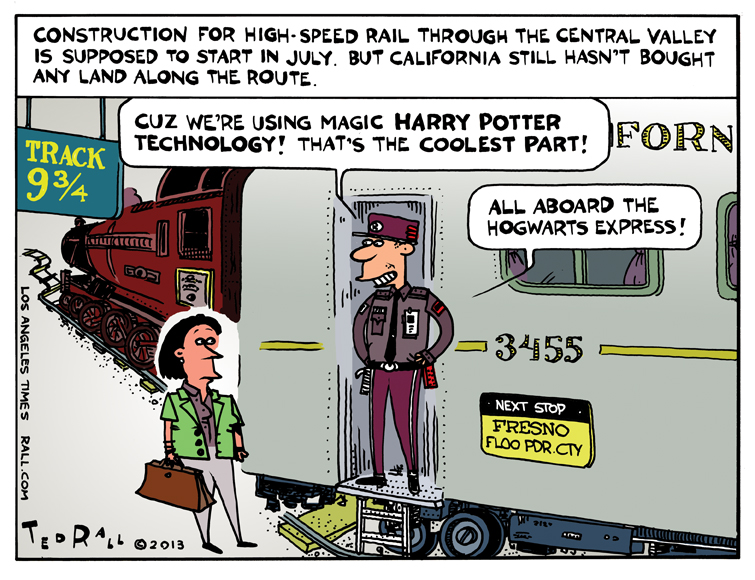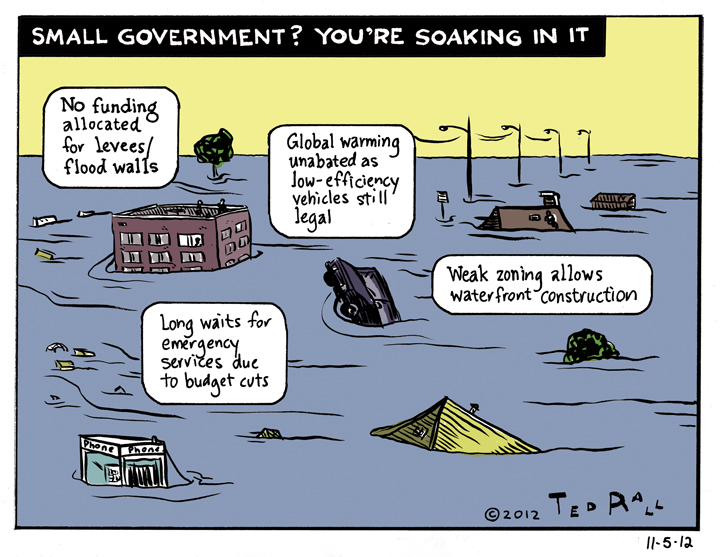
You can tell a lot about the state of a country by comparing the state of its public and private infrastructure.
Take a look, if you can sneak past the gated community guard shack and peek through the privets without getting tackled by a rented goon, at the homes of the wealthy. Note the manicured lawns of the one percenters, fertilized the months recommended by experts depending on climactic zone, painstakingly controlled for weeds, irrigation calibrated by volume, on timers. Check out the garden: lines of shrubs that run a hundred bucks each, red-dyed mulch hiding the dirty brown dirt and tamping down unwanted dandelions before they get a chance to sprout. The driveway is flat, smooth, free of cracks. Stucco walls, if you live out West, are similarly crack-free; if you’re east of the Mississippi, bricks are framed by perfect pointing. Every detail, from the brass numbers on the mailbox to the baseboards to the perfect absence of cobwebs in high ceiling corners, reflects thorough, routine, frequent maintenance and repairs by a retinue of professional service providers.
Tasteful. New. Kept up.
Bear in mind: all this perfectly-maintained stuff houses a single family. At most, we’re talking two parents, four kids and a nanny or two. Certainly fewer than 10 people.
Now look at our public infrastructure.
Drive on a public highway in any major city: New York, Chicago, Los Angeles. It’s a disaster. Potholes so big you worry about breaking an axle. (And you should. In New York State, for example, a recent study estimated that bad roads and bridges cost motorists $20.3 billion in repairs annually.) Cracked concrete and asphalt everywhere. Missing guardrails, stolen signs, and everywhere you turn, garbage. Graffiti and vandalism take a toll but mostly it’s all just old. Old, rusted, worn out, years of “deferred maintenance” — i.e., none at all. Yeah, people throw crap out their car windows — but municipal governments don’t clean it up for days, weeks months at a time.
Connecting two of NYC’s biggest boroughs, the Brooklyn-Queens Expressway is used daily by 160,000 vehicles. It is hideous. It is narrow. It is literally falling apart. Constantly. “With its multitude of trucks and dangerous on-ramps, the BQE is a den of congestion at virtually all hours of the day,” The New York Times reported in 2012. “But one factor has condemned this antiquated 16.8-mile stretch of highway to a place of longstanding infamy in the New York metropolitan area, if not all of urban America: construction that never seems to end. As Gerry Michalowski, a truck driver who has traveled the BQE since 1978, put it, ‘It was under construction then, and it’s still under construction now.'”
Think again about that house I described at the beginning of this column.
It’s used by half a dozen people a year.
The BQE is used by 58 million vehicles a year.
If you don’t think there’s something wrong with this, if you defend the “right” of the wealthy to aggregate more and more until the point when they own everything including our bodies and souls, consider this: rich people have to drive on those roads too. By definition, 580,000 of those BQE users are one percenters.
America isn’t broke, but most Americans are. The reason is simple: too few people have too much of our national wealth. The pauperizing of our common property — the deliberate starving of public funding for roads, bridges, parks, schools, public hospitals, even hospitals charged with caring for veterans of America’s oil wars — reflects the economic and political system’s ass-backward priorities. It’s immoral. Because any society that spends more resources to maintain and upgrade private homes than public works is crazy stupid.
And it hurts the economy.
The American Society of Civil Engineers estimates that the United States needs to spend $3.6 trillion over the next six years to replace and repair the nation’s decaying dams, upgrade its parks and outdated schools, rusting water mains, and our crumbling airports, train and bus terminals, roads and bridges — many of which have deteriorated to Third World standards. (Although, to be fair to the Third World, I’ve seen U.S.-funded roads in Afghanistan in better shape than some in L.A.) The ASCE gives the U.S. a D+ on infrastructure.
The World Economic Forum ranks the U.S. 25th in the world in infrastructure, behind Oman, Saudi Arabia and Barbados.
It doesn’t have to be this way.
Josef Stalin, of all people, showed how infrastructure could be prioritized over private property. The dictator approved every extravagance — and why not? Obama signs off on every luxury the military can dream up.
Determined that his new Moscow Metro be a “palace of the people” for the Soviet capital’s subway commuters, Stalin ordered that no expense be spared to create a system that was not only fast and efficient, but beautiful. “In stark contrast to the gray city above,” The Times wrote as late as 1988, “the bustling, graffiti-less Metro is a subterranean sanctuary adorned with crystal chandeliers, marble floors and skillfully crafted mosaics and frescoes fit for a czar’s palace.” With good reason: first Stalin had chandeliers ripped out of the czar’s old palaces and moved underground; for future stations he had even more stunning ones designed from scratch using radically innovative techniques.
The Moscow Metro remains a showcase of what socialism could do at its best: prioritize the people and thus improve their daily lives.
Then there’s us.
Earlier this week President “Obama appeared at the I-495 bridge over the Christina River in Wilmington, Del., a span that has been closed since June, when engineers discovered that four of its columns were leaning to one side. That has created a traffic nightmare for the 90,000 vehicles that travel the major East Coast highway every day.”
The President went to Delaware to “announce new initiatives to encourage private-sector investment in the nation’s infrastructure, including the creation of a ‘one-stop shop’ at the Department of Transportation to forge partnerships between state and local governments, and public and private developers and investors.” In other words: the usual too little, too late, and even that probably won’t happen.
You know you’re in trouble when you look up to Stalin.
(Ted Rall, syndicated writer and cartoonist, is the author of “After We Kill You, We Will Welcome You Back As Honored Guests: Unembedded in Afghanistan,” out Sept. 2. Subscribe to Ted Rall at Beacon.)
COPYRIGHT 2014 TED RALL, DISTRIBUTED BY CREATORS.COM


